Image by skeeze from Pixabay
Ever increasing amounts of atmospheric
CO2
is
the foremost issue threatening our planet.
It is at the heart of Global Warming
and
the Climate Emergency.
Let's ask scientists about splitting CO2 as a possible solution to the Climate Emergency.
Why not split it?
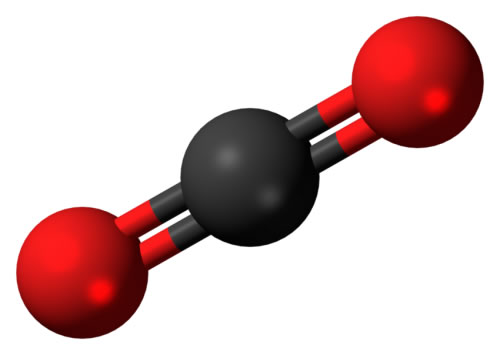
Carbon Dioxide / CO2 = One Carbon atom and two Oxygen atoms.
CO2 Laser UC Davis Research to Split CO2

CO2 Excited CO2 C + 02 Products
|
Can we neutralize CO2 by splitting it? |
Research to split Carbon Dioxide (CO2) was conducted by scientists at the University of California, Davis, in 2014.
CO2 had been split before by others, but the result produced two dangerous products:
Carbon Monoxide (CO) and Ozone (O3).
Carbon Monoxide is poisonous, and Ozone in the air we breathe can damage our lungs. Ozone—in 'The Ozone Layer'—is not dangerous 6 to 31 miles up. It performs a vital service by shielding the Earth below from UV - Ultra Violet radiation.
The UC Davis work is exciting,
and it
inferred a Carbon and Oxygen result.
Consider the profound implications of that.
They took the most ubiquitous Greenhouse gas there is and split it into two benign products, neither one by itself a Greenhouse gas.
Without addressing in any way the planetary crisis precipitated by excess atmospheric CO2— which crisis was already a major concern back in 2014—they indicated that their process might be useful in "alien atmospheres rich in Carbon Dioxide to produce Oxygen."
Their implication of that statement might be:
"We don't think it's useful here on Earth."
The amount of actual splitting that took place was a small fraction of the zapped CO2 passing through their experimental laboratory device.
For the pessimist, that could be the death-knell for furthering any research into this work.
For the optimist, innovation, refinement, insight, computer power and concerted effort to improve a desired result are the essence of scientific research when there is a practical goal in mind.
The lead researcher of the CO2 splitting work was a grad student at the time, is now a professor, and was supported by several UC Davis professors in pursuing this effort.
The doomsday clock is nearing midnight.
Our Earth is truly in the balance.
Action to reverse course is needed now.
It is impossible to overstate the urgency of CO2 splitting efforts like this one. If a splitting process could be perfected, we might have one more planet-saving climate solution in our hands.
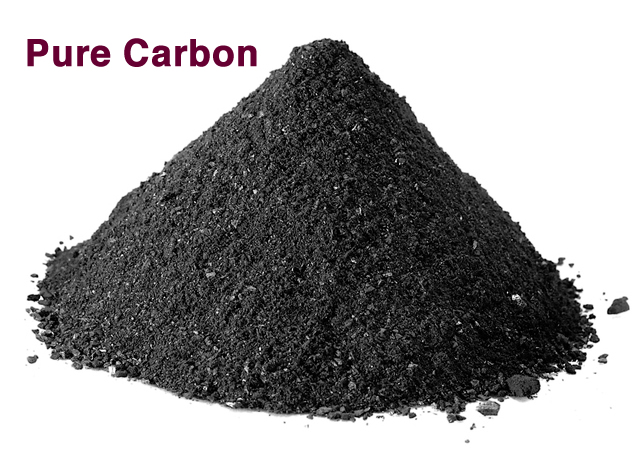
Pure Carbon
If splitting were to become a viable technology, then it might very well become a principal method of choice for excess CO2 reduction.
To be sure, unprecedented scale reforestation, a 95% ending of our slavish reliance on fossil fuels and producing only cars and trucks which remove CO2 from the sky might necessarily complement and be among many other powerful remedial efforts to moderate atmospheric warming.
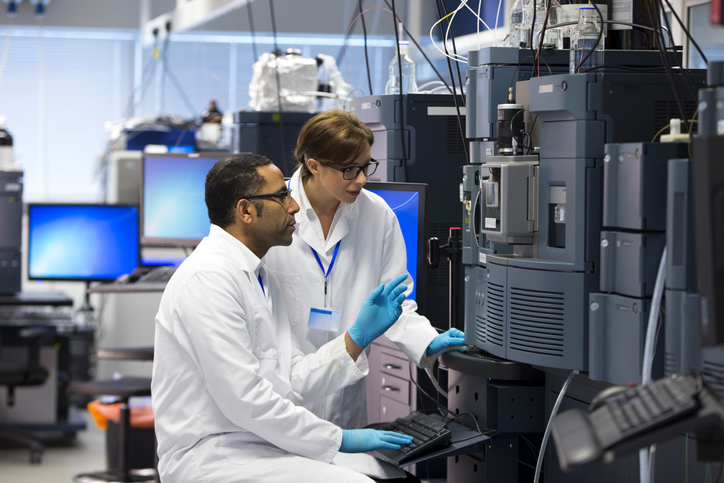
Is splitting CO2 just a pipe dream?
Is the amount of energy required to split even a tiny amount of CO2 off the charts, and thus too expensive to pursue?
There does not appear to be much scientific evidence to justify that assertion. But consider if that were the case—for the benefit such a technology might provide—cost once again would not be the primary consideration.
Some have indicated concerns that if you could split CO2, you would create a new problem: mountains of Carbon that would readily re-attach to Oxygen; then we're back where we started.
Maybe so, and maybe not. If you know something about that dynamic, or have a more general understanding of the chemistry of the possible splitting of CO2, please send your understanding to:
SuggestionsFireDrones@gmail.com
Still, if it could be done, isn't our technical ingenuity sufficient to find dynamic and scalable work-arounds to that possible obstacle?
What about the billions this will cost?
The first question always asked regarding fielding any global solution to reverse Global Scorching is: "OK, but really, what's this going to cost?"
Let World War Two be our model and our answer: There is no ceiling to what we must spend to reverse course. To not understand that is to be unaware of the existential crisis we are now in the midst and mercy of.
Saving our planet, our civilization, our culture, our forests, fields and Tundra, our flora and fauna, and all the people inhabiting our globe has no price tag.
Regarding splitting CO2 on a large enough scale, and if that splitting resulted in a civilization-saving diminution of atmospheric heat, then who would choose not to commit to the spend?
In pursuing the research—with a commitment made to scalable effort—only abundant clean solar, wind and Hydrogen energy would be utilized in any global project. ENERGY.GOV
Vaccines for COVID-19 were produced in historically record time. Might a similar scientific effort work for designing CO2 splitting regimens?
THE FASTEST VACCINE IN HISTORY - UCLA HEALTH
(Please continue reading;
go to the top of the right-hand yellow column.) |
It is curious that so little scientific attention has been given to splitting excess atmospheric CO2—it being by far the main driver of the Climate Emergency.
To the best of our knowledge, the UC Davis research was never followed up by others, nor did they indicate a rationale for not refining the process to bring it up to scale here on Earth.
There is no commentary online or in the literature that can be found about this effort, and there appears to be no one else in the scientific community working on it.
"Well, if no one's following it up, then that must mean it can't be done."
We might agree with that statement if there were others who failed in similar efforts, or scientists who stated in peer-reviewed research that splitting CO2 is neither perfectable nor sufficiently scalable to matter in order to reduce its concentration in our planet's atmosphere.
Repetition to produce a useful result is a long established objective in science and technology. Thomas Edison famously performed 2,774 attempts to get just the right filament for the first practical and marketable electric light. RUTGERS
At least one team of scientists had attempted to obtain more information from the UC Davis crew, but to the best of our knowledge, their correspondence was not answered.
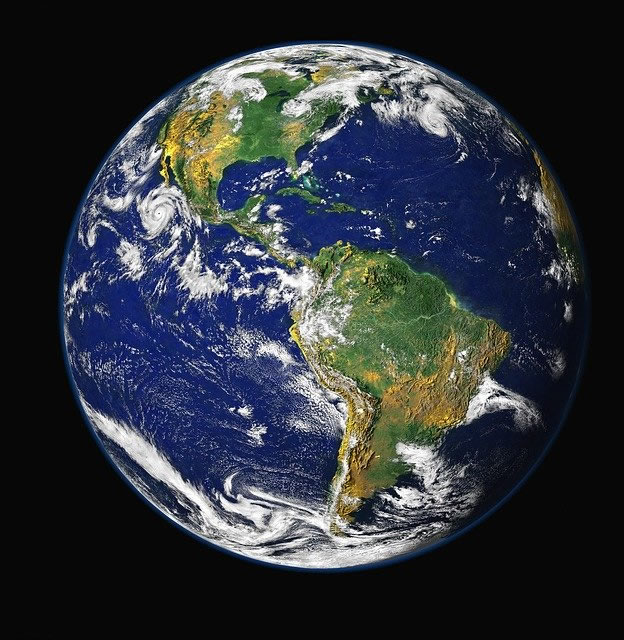
Image by WikiImages from Pixabay
We are left with a mystery,
and a powerful possibility:
• Could the technique be improved, made more efficient, and could it be brought to scale to be one more powerful technical tool to reduce the percentage of CO2 in our atmosphere?
• Could the goal of that invention be to decommission as much CO2 as is necessary so that its atmospheric presence—now at about 421 ppm*—would once again fall below the target of 350 ppm, and in as brief a period of time as human ingenuity can muster?
• If we could reach 350 ppm, could we choose to go even lower—to 280 ppm—and return global temperatures to pre-industrial levels?
Winters would again be very cold, and lakes would freeze. Glaciers would halt their retreat, and perhaps even start growing. Ski slopes everywhere would be covered with snow. Warm winter coats would again be in vogue. Winter Olympics would continue to thrill us.

We've been to Pluto and beyond..
What we dream, we can do.
Given focus, scientific effort and funding...
• Could a Manhattan Project-style effort secure the goal? Could teams of hundreds of scientists and engineers, invited from all over the world, and given unlimited financial resources, perfect potent and efficient CO2 splitting devices?
• Could millions of globally deployable splitting devices then be produced at whatever scale, cost and speed is required to turn the tide?
• If such an endeavor could work—and it was combined with reforestation efforts, launching wildfire quelling Fire Drones, and directing our global vehicle fleet to endlessly devour CO2— then is it possible we could actually solve a good portion of our Climate Emergency challenge?
Given the extinction-level event our civilization will soon be confronting, that would seem to be an effort worthy of funding and fielding—even if the risk of failure was deemed a possibility.
We're all interested in fielding plans that will reverse Global Warming. Let's have scientists— and chemists in particular—weigh in concerning the efficacy of this particular remedy.
VICE and SCIENCE • and also PHYS ORG
The Science citation offers a publically available abstract written in accessible language but with limited information. Subscribers to this professional journal, or with access to a university library, can view the full paper, which contains the actual research details.

* Parts-per-million (abbreviated ppm) is the ratio of one gas to another. For example, 421 ppm of CO2 means that if you could count a million gas molecules, 421 of them would be Carbon Dioxide and 999,579 molecules would be other atmospheric gases.
|
|
|

Supercomputers performing billions of calculations
per second
might
support scientific efforts to design
optimally functioning CO2 splitting devices.
|
|
|
Would splitting CO2 actually work??
|
 |
Let's have scientists and engineers weigh in on the matter. If there's an indication that CO2 splitting might be possible in large scale installations, let us build a prototype.
If there's a sense that this technology might in fact have a beneficial part to play, then let's improve it, invest in it and field it.
If there's no positive result, we can say we did our best and put our focus elsewhere. We will learn useful data even if we fail. |
|
|
| |
|
| |
|
Solar power is poised to become orders of magnitude more efficient than energy sources derived from fossil fuels. There will no longer be a rationale for powering society with dangerous polluting sources.
Electricity from Solar Cells - MIT research has produced working solar cells that can generate 400 times the energy of a standard rooftop solar panel, area for area.
https://news.mit.edu/2016/ultrathin-flexible-solar-cells-0226

MIT Solar Energy Technology
just might change everything...
"The new type of solar is coming. In the next five years, we'll have access to more readily deployable, lighter, very inexpensive solar energy, generating electricity at less than
2¢ per kilowatt-hour."
- Vladimir Bulovic • MIT-nano • Spring, 2019.
ENERGY MIT
2¢ kWh current cost comparison:
In the US, as of 2019, Louisiana had the lowest rates at 9¢ per kWh, Hawaii the highest at 33¢ per kWh and the average for all 50 states, 14¢ per kiloWatt hour.
ELECTRIC COST / Costs are rounded.
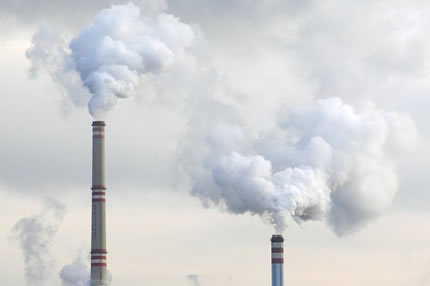
A farewell to fossil fuels forever?
2¢ per kWh is good news for electricity consumers everywhere; that's great news for the environment—there will no longer be any excuse for continuing to utilize fossil fuels or nuclear for producing electricity.
|
The batteries of the future are here now.
They carry more clean energy than ever before. Breakthrough batteries will allow for dynamic range in vehicles, as well as fuel a host of other energy needs.
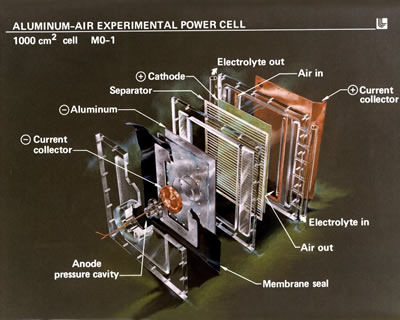
Aluminum-Air Power Cell: Energy.Gov: Public Domain
Light weight Aluminum-Air Batteries are able "to produce electricity from reacting to the Oxygen in the air. They have the potential to produce 8 times the energy of a Lithium-ion battery with a significantly lower weight." However, considerably more research is needed to bring them to the point where they become reliably rechargeable.
WIKIPEDIA and DESIGN NEWS
Aluminum Ion Battery Technology - "An aluminum-based rechargeable all-solid-state battery appears highly promising for meeting future demands. Aluminum, in fact, possesses one of the highest theoretical volumetric (energy) capacities of all elements."
FRONTIERS IN CHEMISTRY
IBM's New Battery Technology - "IBM Research is building on a long history of materials science innovation to unveil a new battery discovery. This could help eliminate the need for heavy metals in battery production and transform the long-term sustainability of many elements of our energy infrastructure."
IBM
Photo Acceleration of Lithium-Ion Charge
And if we wanted to stick with popular Lithium-Ion batteries, then we could expect that "..the charging rate of a cathode can be dramatically increased via interaction with white light." Check out this timely and important work: "Photo-accelerated fast charging of Lithium-ion batteries." NATURE
Nobel Prize laureate's recent work: "Lithium-Ion Battery Inventor Introduces New Technology for Fast-Charging, Noncombustible Batteries - A team of engineers led by 99-year-old John Goodenough, professor in the Cockrell School of Engineering at The University of Texas at Austin and co-inventor of the Lithium-ion battery, has developed the first all-solid-state battery cells that could lead to safer, faster-charging, longer-lasting rechargeable batteries for handheld mobile devices, electric cars and stationary energy storage." UPDATE: With sadness, we announce that Dr. Goodenough passed away on June 25, 2023. His life was long and productive.
UNIVERSITY OF TEXAS
|
|
|

 |
| |
|
| |
|
IMPORTANT NOTE:
Much of the rest of this page is devoted to an understanding of
global atmospheric
Carbon Dioxide and Methane proliferation.
There is important information concerning the science of catastrophic warming,
as well as a discussion of the urgent work our civilization must quickly engage...
...if we and our children, as a civilization, are to survive.
|
|
| |
|
| |
|
The Titanic is a metaphor for our civilization.
Yet, that was just one ship...
Today, the actual fate of the world
depends upon utilizing all the means
at our disposable in order to reverse course.
|
|

Ismay declares:
"But this ship can't sink."
Thomas Andrews replies:
"She's made of iron sir...
I assure you she can, and she will."
Like the ill-fated Titanic, our global ship can certainly sink—yet unlike the Titanic, it doesn't have to if you and I choose to save it.
We still have time to reverse course. The most important thing any of us can do
is to get involved. That means all of us who are not climate scientists or movers and shakers in government can still choose to get involved on a truly meaningful level.
Let's make it our business to direct governments and corporations
to make the approaching climate disaster our top priority. It's now up to all of us to rise to the occasion and make our voices heard... loudly and clearly.
March, demonstrate, join and/or support climate-related organizations, meet with others, write and call legislators, get on the phone with a corporation that pollutes, become informed about the issue. Don't take it for granted that people are working on it and therefore "I don't have to." It doesn't matter if you are 10 years old or 100... it's your voice that will shape the future.
With enough voices joining the chorus, we can create a paradigm shift that will change the course of history. With enough companies choosing to do the right thing, we can look the future in the eye. With legislators of all parties and in all nations doing the soul-searching to allow them to recognize that we will only get one chance at saving our planet, their commitment can make all the difference.
With governments and international organizations getting on board, we can alter the ominous warming trajectory that is happening right now, as we speak.
The atmospheric release of Carbon Dioxide into the sky taking place right now —and the 80 times more potent Methane waiting in the wings for just a little warmer Northern Tundra— demands we recognize that reversing these actual armaggedon signposts is now Priority One for our precious planet.
We won't get a second chance.
Consider your children, the flora, and the fauna all over our magnificent globe. They deserve a lot better than our handing them a scorched and dying planet.
We must quickly implement sober courses of action that will turn the tide. Please consider jumping on board this powerful train that is committed to saving YOUR world... It's just that important. |
|
|
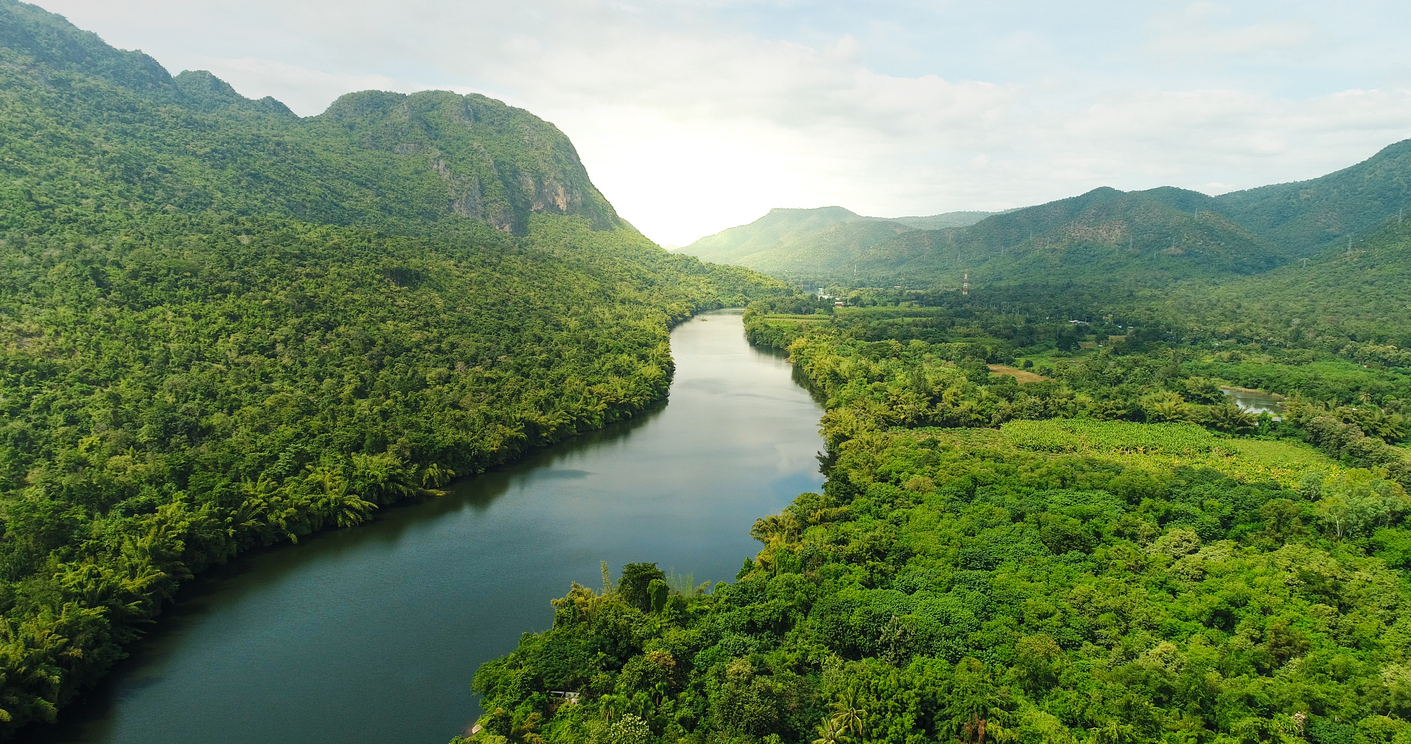
Are our forests far away?
They are as close as our next breath.
The Amazon, and all of the world's trees
and forests do something truly amazing:
They breathe in Carbon Dioxide (C02),
and breathe out newly minted Oxygen (O2).
( Nature designed you to do just the opposite! )
Without our world's forests, and without
the Amazon, the amount of natural Oxygen
production will fall precipitously, and the
result will be a global atmosphere that may
just become insufficent for... breathing.
Carbon Dioxide & Methane proliferation
into our atmosphere is the challenge of
our age... and precious time is running out.
Without making
it the challenge of our
age, we will all most certainly perish.
We live in a world where most of us think
it's not that bad, and we'll somehow manage.
The explosion of CO2 and Methane into our
sky is not a fairytale; it's
not a story; it's
not a lie, and if ignored it will surely be
at our civilization's great peril.
CO2 / Carbon Dioxide proliferation causes
continually rising atmospheric temperatures.
That dynamic is also now in the nascent
process of releasing untold amounts of
Methane in the Northern Tundra.
The more Methane released will cause
atmospheric heat generation to release
more and greater amounts of Methane
to fill our Planet Earth's delicate sky.
That is THE most dangerous vicious
cycle our civilization must contend with...
and precious time is of the essence.
Methane is the simplest hydrocarbon,
consisting of just one carbon atom...
...and four tiny hydrogen atoms.
Methane is also an amazingly and
ferociously potent Greenhouse Gas.
Methane is produced by various elements
in the soil itself, as the
Tundra's vast
Permafrost warms sufficiently to allow it.
Methane is 80 times more potent than CO2.
Make that a number you choose to not forget.
And, the shear amount of that potential
release of
Tundra-formed Methane is indeed
sufficient to destroy all or most life on earth.
An achievable goal is relatively simple:
LET'S BEGIN REMOVING CO2 FROM THE SKY...
AND LET'S LEGISLATE A COMPLETE END TO
HUMAN-GENERATED CO2 INTRODUCTION
INTO OUR SKY.
For example, legislate and demand that
factories, vehicles, and anything that emits
atmospheric CO2 must grind to a halt.
CO2 ? Hey, weren't
we talking about
the off-the-charts dangers of
Methane??
The distinction between the two is this:
If we don't begin removing CO2 from our
global atmosphere as fast as humanly
possible, and if we don't stop blasting
it into the sky everywhere, then the Methane
now forming in the ground, in and under the
Permafrost in the vast Northen Tundra, will inexorably rise up into the atmosphere...
as all the
vast Permafrost begins to thaw.
The ferocious tornados we now see on the
news every day of our warming atmosphere
is the unassailable evidence that common
sense, climate action, and massive,
overwhleming intervention are now
required to protect our future.
It doesn't matter where on the planet we
remove CO2. However, it most certainly
does matter if we don't or we won't prevent
the Northern Tundra from melting and
releasing its mighty planet-killing Methane.
We can deal with the CO2 if we have the
political will, and if we make this
conversation
paramount and ubiquitous.
There are
truly no more important
goals for humanity than those.
WE DON'T HAVE 20 YEARS TO FIX THIS...
The RATE of CO2 / Methane release into
the sky is not only increasing, the RATE
of the RATE is also increasing.
Imagine an atmospheric heating curve that
becomes dramatically steeper every year.
IF we don't deal with CO2 proliferation
now, as the thawing takes place
in the
Northern Tundra,
the ensuing heat will
very likely be
lights out...
all over the world.
No one has a crystal ball as to the 'point of
no return timeline.' However, it is entirely
possible that, without utilizing every
resource we have, and mobilizing our
governments everywhere to take action,
the 'lights out' date for our world is perhaps
a mere ten years from today, 2024.
Talk about Methane whenever you can.
Be a part of the solution, and get involved.
|
|
|
The world's forested regions produce a good portion of the Oxygen we breathe—about 20% of it. They also sequester CO2—the CO2 nature intended, and some of the excess CO2 industrial civilization has added to the mix.
"Forests cover 31 percent of the world's land surface, just over 4 billion hectares. This is down from the pre-industrial area of 5.9 billion hectares." 2012 Data • EARTH POLICY • 1 hectare = 2.47 acres.
We think those three trillion trees have our back. Sadly, the opposite might be the case.
________________________________
How much excess CO2 is in the sky now?
How much more is coming down the pike?
It's important, so let's do the math...
It is very difficult for us to conceive of something floating up there in our atmosphere as having weight. Yet, doing so allows us to begin to appreciate the gravity of our situation.
If we swap out CO2 for jumbo jets, we can get a feel for how much weight that excess CO2 is; and, we can also get a vague sense of the vast atmospheric volumes that human-generated CO2 floating in our sky inhabits.
A gigatonne is 1,000,000,000 tonnes. That's one billion, and equivalent in weight to three million Boeing 747 jets. ENERGY EDUCATION CANADA
Now multiply three million x 950..........
= 2,850,000,000 jets' worth of weight.
Yes, that's 2 billion 850 million 747's.

A Boeing 747
"From 1850 to 2019, 2,400 gigatons of CO2 were emitted by human activity. 950 gigatons went into the atmosphere. The rest was absorbed by oceans and land."
THE WORLD COUNTS
Now add to that 'If all our forests burn...'
170 tonnes (187 tons) of CO2 is released with each hectare of forest burned. If all the world's forests burned—4 billion hectares—the volume of CO2 released would equal 680 gigatons.
That infusion—which might occur over the course of this decade and the next—is just 28% less than all of the anthropogenic (human caused) CO2 introduced into the sky since 1850—a span of 150 years.
If we conservatively factor out 'oceans and land,' the impact is still equivalent to about 39% of that 150-year CO2 addition to the sky.
That astronomical amount of airborne Carbon Dioxide is beyond our ability to conceptualize.
If we don't intervene to alter that ominous current trajectory, 265 gigatons of CO2 could be introduced into the atmosphere over the course of this decade from the existential horror of incinerated forests alone.
That's in addition to the 30 to 40 gigatons of car-truck-bus-rail / large ocean going ship / industrial / military / airline / home and office / oil and gas drilling / coal / fracking / agriculture and farming generated CO2 we currently pump into our fragile global atmosphere every year.
Ongoing atmospheric CO2 pollution always increases average temperatures which in turn always increases the area of wildfires which in turn always releases more CO2.
It is the most dangerous vicious cycle we might imagine, and it is happening right now.
The world's forests—profoundly overwhelmed by growing atmospheric heat and desert-like dryness—may careen toward a tipping point in the next few years. The stage is now set for uncontrollable burning, which in turn will usher in a new and perilous phase for life on Earth. The Anthropocene—the current epoch—will give way to The Calorocene: The Age of Heat.

Forests which no longer exist can no
longer sequester CO2 nor produce Oxygen.
Setting aside the grandeur of our forests, the products we derive from them, or the flora and fauna that thrive in their majestic halls, the result would still be catastrophic due to the monumental increase of atmospheric CO2.
Now let's add-up the total amount of excess CO2 which might accumulate in the sky in the next 10 to 20 years if we fail to change course: 700 to 1,000 gigatons.
The initial consequences will be a much hotter planet seemingly overnight; over time, we might very possibly experience the worst-case scenario: our planet Earth becomes too hot for human habitation.
Gigatons of CO2 = Rising Temperatures
Rising Temperatures = Firestorms, rising seas, drier fields and forests, much larger and more destructive hurricanes, much more powerful tornadoes, melting glaciers, extinction of countless plants and animals, and the end of normal seasons as we've known them for the last thousand years. Everyone you know will experience life becoming more difficult in every way possible. The collapse of civilization as we know it is a possibility that cannot be ignored.
Recall the hottest day you ever experienced—the one where you couldn't wait to get into some space where the air conditioning was plentiful, delightful and blowing cool.
Imagine what life would be like if that daily heat occurred all year round, with no respite.

When it comes to wildfires, talk of sorting it all out by 2050 is dangerously unrealistic.
This un-natural disaster is not something that will happen in the distant future. It is an event, or series of events, which has already begun.
Gargantuan Megafires produce two evils, both of which are hugely detrimental to our planetary well-being. 1) A burned forest releases enormous amounts of Carbon Dioxide into the atmosphere, and 2) that burned forest can no longer sequester Carbon Dioxide. Of all the bad things Global Scorching is bringing us, this is the most unspeakable consequence.
Megafires which cannot be contained will destroy a good portion of our forested lands, all over the world. They will also emit so much CO2 that nothing we will subsequently do to address the many other climate issues will matter.
What is required—in this most important of choices our civilization might ever make—is to bring all wildfires anywhere they occur under control within the next 5 to 7 years.
Some say that Methane has a short life in the sky, and so we may not have to worry so much. While it's true that Methane has a relatively short life, but so too are those precious
few years we have left.
We won't escape the Methane juggernaught if we don't first contain the human-caused Carbon Dioxide. CO2 lowering is the only ticket to slow the Methane release now taking place in the Tundra.
We can avoid the worst of it if we commit to prioritizing a robust worldwide Fire Drone navy.
"Well, wouldn't it be better to just stop polluting the sky with Carbon Dioxide?" That is a sentiment that is true up to a point. The problem is that time is running out.
Directly addressing the calamity facing our forests—and utilizing actual global scale resources and advanced technology to insure success—is the only way we will survive.
"Yes—but what if that analysis is wrong? What if the forests don't all turn to ashes over the next ten years?"
It's possible we could be wrong.
But are we willing to take that risk and not address the likely possibility—that without protection—all of our forests could actually burn to the ground, with no resurrection possible?
We would then be thankful for the blessing of time which permitted us to build an invincible global MegaScale Fire Drone defense system.
Gambling with our future is not a sensible strategy for ensuring our civilization's safety.
We can be depressed, shrug our shoulders, or hope that someone else will handle it. As corny as it sounds, if ever there was a time the planet needed your hands-on support, that time is now. Invite yourself to get involved.
Clamping down on ALL CO2 emissions whenever and wherever they propagate is the goal and...
we must also implement technologies to REMOVE all excess CO2 from our overburdened atmosphere at an uncompromising global scale.
In just the past six years—2019 through 2024—we've all witnessed an unexpected, unimaginable, and awesome new phenomenon—intense and seemingly boundless Firestorms (AKA Megafires) wreaking havoc in Australia, the USA, Canada, China, Russia and many other locales. Our attempts to control them were scorned and brushed aside by an unforgiving Nature. Canadian wildfires turned North America's sky a sinister gray for two months in the Summer of 2023.
There's no reason to presume that those events were a fluke. It is more likely they are a terrifying harbinger of what is to come.
We can no longer call them forest fires or even wildfires: Firestorms are the new normal. They are intense and travel faster than any other wildfire. They create their own wind and cloud systems, and their own lightning. They let us know that we've entered an uncharted and lethal phase of the Climate Emergency.

The cause of this ongoing threat?
CO2 continues to flood the sky in break-neck quantities, every minute, every hour and every day.
That new CO2 adds to the 1,700 or so gigatons of human-generated CO2 and naturally produced CO2 already floating up there—with the grim result being a warming curve of atmospheric temperature increase with no end in sight.
|
|
We go about our lives largely oblivious to the existential wolf at our door. Most of us are unaware of what is happening; those among us who are concerned and aware quickly forget.
In the past, we were unable to see the specific, identifiable and concrete results of anthropogenic CO2 release into the sky. That allowed us to pretend things weren't so bad.
Today, the evidence of this burgeoning catastrophe is all around us, and the plight of our global forest range exemplifies and renders the issue as plain as day.
We all bemoan the heartless and criminal deforestation of the Amazon by Brazil, yet we— in our gross ignorance—are about to inflict a worse fate on our own precious forests.
METHANE
..................
As if all those danger signals weren't enough, Methane is waiting in the wings to release its devastation on our planet. Methane is 80 times more potent than is CO2. Unlike CO2, which we have the ability and technology to corral, were we to make it our number one world-wide priority, Methane cannot be contained once released from the melting Northern Tundra.
If we permit it to be released because we haven't reversed CO2 pollution and heat, and have allowed the Northern Tundra to utilize its Methane to destroy our atmosphere, then that will be the end of civilization as we know it, and likely the tragic end of our planet...
within a decade or less.
Let that sink in. Talk to everyone you know and ask them if they know about CO2 proliferation, and as importantly, if they know about the horrific dangers of an unstoppable Methane release, and its planet killing potential.
Let's appreciate that an intense strategic world-wide Fire Drone strategy will do more than protect forests, property, and prevent the loss of countless lives.
A globally deployed MegaScale Fire Drone commitment can prevent the literal extinction of our forests and their living contents. It will also be crucial to our survival as a species and a civilization, and it's very likely the only way to avoid the Methane Monster lurking in the wings.
Fire Drones will save our forests. China has demonstrated NOW, that its firedrones are able to quash intense forest fires almost anywhere.
All nations can choose to spend what it takes to do just that as well.
We can and must also tap the massive and unending power of our planet's rivers to achieve our survival goals.
Millions of Turbines could be placed in those rivers; they would be submerged and safe. Their goal would be to power tens of millions of onshore CO2 capture devices all over the world, and, as well, remove and sequester gargantuan quantities of CO2 directly from our rivers, 24/7/365.
Some might say that the scale of such endeavors is too expensive. However, consider that in order to achieve the goals necessary to halt that inevitable Climate Scorching racing towards us, should we choose not to act, spending liberally and freely must be the order of the day, and the first order.
Among many designs now being considered, Fire Drones and tasked Rivers would be among the most potent designs to save our civilization and our planet. They can also save our future.
|
|
|
|
| |
|
| |
PERMAFROST at the top of the World,
CO2 (Carbon Dioxide) & METHANE.
Tell me: Whats the relationship??
...AND, HONESTLY, WHY SHOULD I OR ANYONE BE CONCERNED ABOUT A BUNCH OF LAND FAR AWAY, AND ABOUT PERMAFROST AND METHANE??
This is what Permafrost which has
become
warmer than 32°F (0°C) looks like.
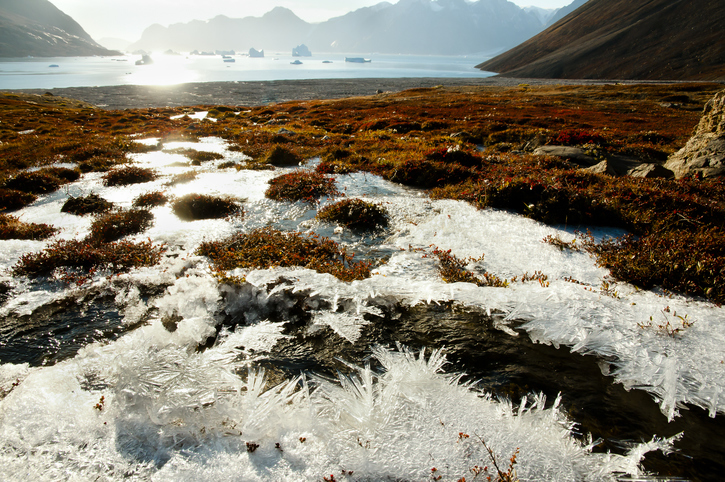
Heck... it doesn't look like much.
But the fate of the world is literally in
our
ability
to
prevent
the vast majority of Permafrost from going from "frozen" to "thawing." Another way of putting it is that our entire global society must be dedicated at any cost to the prevention of the Northern Permafrost from literally "losing its cool."
OK... What exactly is Permafrost?
Permafrost is any ground that remains completely frozen—
32°F (0°C) or colder—for at least two years straight.
These permanently frozen grounds are most common in regions with high mountains and in Earth's higher latitudes—near the North and South Poles. NASA
Permafrost covers approximately 22.8 million square kilometers
(about 8.8 million square miles) in Earth's Northern Hemisphere.
That's a very important mass for several reasons. First and foremost, it's where the Tundra and Permafrost reside, as we've been examining. Secondarily, preventing its demise is as important as any goal our planet has ever challenged.
Paradoxically, we can only protect it, and its permanently sequestered METHANE, by making sure that we halt the CO2 / Carbon Dioxide we blast
into the sky every minute of every day.
Halting atmospheric CO2 proliferation and reversing it is crucial in its own right; but it's also the only technology that can PREVENT the planetary atmospheric heating catastrophe that an unbridled METHANE release at the top of the earth will deliver to every single corner of our planet...from the North Pole to the Equator.
A big task... most certainly...
but one that
our
civilization
can and must accomplish.
If all the Permafrost everywhere slides under 32°F (0°C) or warmer due to a climate that is becoming
hotter
every year, then a runaway Greenhouse
atmosphere
will
cause
our globe's heat index to soar way off the charts.
Ask your family and friends what they know about Methane.
Tell them that Methane
is 80 times more
destructively
potent
a Greenhouse gas than is Carbon Dioxide! And, tell them that the rate of melting in the polar north is FOUR TIMES that of most any other area on the planet. And, you guesed it, that combination is the equivalent of shaving off years of our future... if we don't act to reverse course now.
When next you speak with friends, family, co-workers, neighbors, etc.,
take the time and have the courage to bring up the subject of our
warming Permafrost, and the stark potency of the Methane that is on the cusp of being released, as well as the fearsome and unbearable heat and havoc it would render... everywhere on earth... yes, including a complete melt of The North Polar regions, and yes, including a complete melt of the snow and ice currently blanketing Antarctica. And, yes, that means the seas will rise hundreds of feet everywhere on the planet!
Yes, we worry about CO2 proliferation, as well we should; but that's
the least of our worries when compared to the devastation and heat an unbridled planetary Methane release will explode on our precious Planet Earth.
|
|
|
|
| |
|
| |
|
How much Methane
is released in the Tundra?
September 7th, 2023 • by Niklas Keller
Infinitely vast, not a tree in sight, and with permanently frozen soil: The Tundra is an important Carbon reservoir. Yet climate change is now warming the Arctic regions, causing Permafrost to thaw. A team led by Leonardo A. Galera asked themselves: In which proportion are Greenhouse gases released when Permafrost soils thaw?
Given that Methane is a far more potent Greenhouse gas than Carbon Dioxide, higher Methane emissions would have a more pronounced effect on climate warming. For their study, the researchers measured Carbon Dioxide and Methane flows in dry and moist Tundra soils on Samoylov Island in northeastern Siberia.
As the study shows: A thicker active layer and higher temperatures in the subsoil promote the decay of organic material. This is conducive to the production of Methane. The researchers also discovered that, due to these factors, the ratio of Carbon Dioxide to Methane shifted – that is, that more Methane was produced in relation to Carbon Dioxide.
Although Carbon was also released, primarily as CO2, in moist Tundra soils the Methane concentration was nearly seven percent.
In contrast, the Carbon released was less than 0.3 percent in dry soils.
(That's about a 23% differential— and that's a very big difference.)
These new findings pave the way for new simulations
and processes to more accurately predict climate future.
A. Galera, L., Eckhardt, T., Beer, C., Pfeiffer, E.A., Knoblauch, C. Ratio of In Situ CO2 to CH4 production and its environmental controls in polygonal Tundra soils of Samoylov Island, Northeastern Siberia. jrg Biogeosciences 128,4 (2023).
https://agupubs.onlinelibrary.wiley.com/doi/10.1029/2022JG006956
|
|
|
The Arctic is warming four times
as fast as the rest of Earth.
|
|

"Climate change is warming the
Arctic Tundra
about
four times
faster than the rest of the planet."
|
By Katherine Bourzac • May 6, 2024 at 11:30 AM
"Climate change is warming the Arctic Tundra about
four times
faster than the rest of the planet.
Now, a study suggests that rising temperatures will spur underground microbes there to produce more carbon dioxide — potentially creating a feedback loop that worsens climate change.
The Tundra is “a sleepy biome,” says Sybryn Maes, an environmental scientist at Umeå University in Sweden. This ecosystem is populated by small shrubs, grasses and lichen growing in cold soils rich with stored organic carbon.
Scientists have long suspected that warming will wake this sleeping giant, prompting soil microbes to release more of the Greenhouse gas CO2 (SN: 8/11/22). But it’s been difficult to demonstrate in field studies.
Maes’ team included about 70 scientists performing measurements in 28 Tundra regions across the planet’s Arctic and alpine zones. During the summer growing season, the researchers placed clear, open-topped plastic chambers, each about a meter in diameter, over patches of Tundra.
These chambers let in light and precipitation
but blocked the wind, warming the air inside
by an average of 1.4 degrees Celsius.
The researchers monitored how much CO2 microbes in the soil released into the air, a process called respiration, and compared that data with measurements from nearby exposed patches."
CLICK HERE TO READ THE FULL STORY:
https://www.sciencenews.org/article/arctic-tundra-soil-microbe-carbon-dioxide
and related info here, by Carolyn Gramling • August 11, 2022 at 11:00 AM
https://www.sciencenews.org/article/arctic-warming-faster-earth-climate-change
RELATED TOPIC: Arctic warming causes Permafrost thaw and accelerates microbial decomposition
of soil organic matter (SOM) to carbon dioxide (CO2) and Methane (CH4). https://agupubs.onlinelibrary.wiley.com/doi/10.1029/2022JG006956 |
|
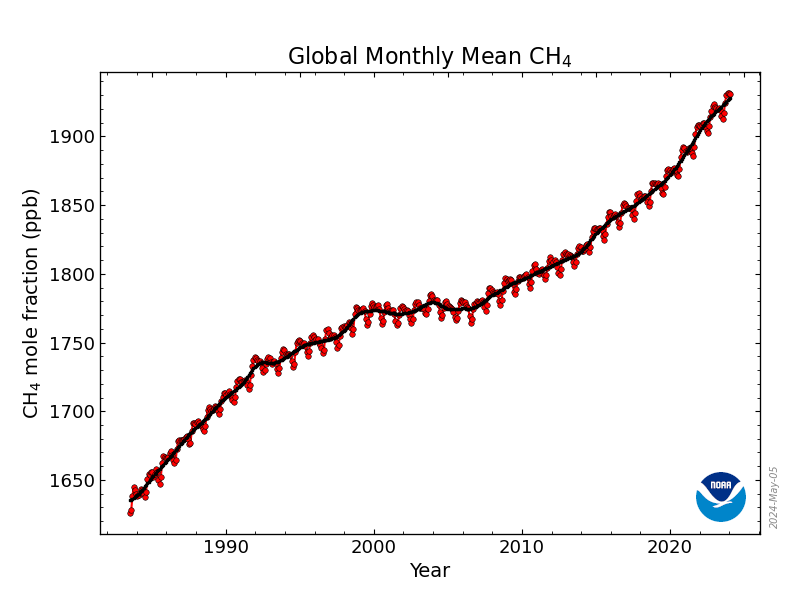
PLEASE NOTE: The figures on the left are NOT dates.
They are indicators of the continuous rise of CH4 / Methane
into our planet's atmosphere
since about 1980.
Methane rising up into our atmosphere
from the thawing
Northen Tundra is
the most dangerous event our planet faces.
Each small red dot represents the amount of Methane in our
atmosphere on any given date. As you can see, it's headed up.
|
|
|
Ratio of In Situ CO2 to CH4 Production and Its Environmental Controls in Polygonal Tundra Soils of Samoylov Island, Northeastern Siberia
"Global warming causes the thaw of the permanently frozen soil in Arctic regions, exposing soil organic matter (SOM) previously frozen to decomposition, increasing the emission of carbon dioxide (CO2) and methane (CH4), which are greenhouse gases.
It is crucial to quantify the ratio of CO2 and CH4 produced because CH4 has a stronger global warming potential than CO2.
We partitioned SOM decomposition into CO2 and CH4 formation (CO2:CH4 ratios) in wet and dry tundra soils on Samoylov Island, Northeastern Siberia, and we related these ratios to environmental variables.
Deeper active layer, which is the topsoil layer that freezes and thaws annually, and higher subsoil (40 cm) temperature at the interface between the active layer and the permafrost, foster CH4 production and decrease CO2:CH4 ratios.
Carbon was preferentially lost in form of CO2 by the soils, but CH4 had a larger contribution to the carbon loss in the wet tundra. Our study indicates that warming and deepening of the active layer can result in rising CH4 production.
Further understanding of in situ CO2:CH4 ratios from SOM decomposition will help improve simulations on future CO2 and CH4 fluxes from thawing tundra soils."
The above content is the simple conceptualization.
If you want to view the in-depth science, please click here:
https://doi.org/10.1029/2022JG006956
|
|
|
| |
|
Melting ice is slowing Earth's rotation, shifting
its axis and even influencing its core, study shows
Jul. 16, 2024, 6:48 PM EDT • by Evan Bush | NBC NEWS
Climate change is altering the Earth to its literal core, new research suggests.
As polar and glacial ice melts because of global warming, water that was once concentrated at the top and the bottom of the globe is getting redistributed toward the equator. The extra mass around Earth’s middle slows its rotation, which in turn has a lengthening effect on our days.
A new study offers more evidence of that dynamic and further suggests that changes to the planet’s ice have been profound enough to affect the Earth’s axis — the invisible line at its center around which it rotates. Together, those shifts are causing feedback beneath the surface, affecting the fluids that move around in Earth’s molten core.
The findings were published in two journals, Nature Geoscience and Proceedings of the National Academy of Sciences, over the last week.
The studies, along with similar research published in March, suggest that humans have tinkered with foundational elements of the planet’s physical properties — a process that will continue until some time after global temperatures stabilize and the melting of ice sheets reaches an equilibrium.
“You can add Earth’s rotation to this list of things humans have completely affected,” said an author of the two new studies, Benedikt Soja, an assistant professor of space geodesy at ETH Zurich in Switzerland.
The alteration to Earth’s spin is significant enough that it could one day rival the influence of tidal forces caused by the moon, Soja said — if carbon emissions continue at extreme levels.
In general, the speed of Earth’s spin depends on the shape of the planet and where its mass is distributed — factors governed by several counteracting forces.
Scientists often offer a comparison to a figure skater twirling on ice: When skaters spin with their arms outstretched, their rotation will be slower. But if skaters’ arms are kept in tight, they spin faster.
Somewhat similarly, the friction of ocean tides from the moon’s gravitational pull slows the Earth’s rotation. Historically, that has had the largest influence on the planet’s rate of spin, Soja said.
Meanwhile, the slow rebound of the Earth’s crust in some high-latitude regions after the removal of Ice Age glaciers works in the opposite direction, speeding up the planet’s spin.
Both of those processes have long been predictable influences on the Earth’s angular velocity.
But now, rapid ice melt due to global warming is becoming a powerful new force. If humans continue to pollute the planet with carbon emissions, Soja said, the influence of ice loss could overtake the moon’s effect.
“In the worst scenarios, then yeah, climate change would become the most dominant factor,” he said.
An important fourth factor influencing Earth’s spin is the motion of fluid within its core. Scientists have long understood that that can accelerate or slow the planet’s rotation — a trend that can shift over 10- to 20-year intervals. Right now, the core is temporarily causing the Earth’s spin to speed up slightly, counteracting the slowing due to climate change. Climate change appears to be affecting Earth’s core, as well, as a result of melting ice and shifts in the planet’s rotational axis.
The researchers behind the new study built a 120-year model of polar motion, or how the axis shifts over time. They found that changes in the distribution of mass on the planet due to melting ice likely contributed to small fluctuations in polar motion.
Soja estimated that climate change was most likely responsible for 1 meter of change over 10 years.
The research further suggests that the movement of molten rock inside the Earth adjusts to the changes in its axis and rate of spin — a feedback process in which Earth’s surface influences its interior.
“The rotation changes slightly, and that, we believe, can indirectly have an effect on the core,” Soja said. “This is something which is not very easy or not possible to measure directly because we cannot go down there.”
The findings have implications for how humans keep time and for how we position satellites in space.
“If you want to fly a new mission to Mars, for example, we really need to know how the state of the Earth is exactly in space, and if that changes we might actually make a navigation error or a mistake,” Soja said.
A 1-meter change to Earth’s axis, for example, could mean a spacecraft misses its target by 100 or 1,000 meters when it reaches Mars.
As for timekeeping, research published in March suggested that climate change has delayed the need to add a “negative leap second” to Coordinated Universal Time to keep the world’s clocks in line with Earth’s rotation.
Duncan Agnew, a geophysicist at the Scripps Institution of Oceanography at the University of California, San Diego, who led that earlier study, said the new research “meshes very well” with his work.
“It extends the result further into the future and looks at more than one climate scenario,” Agnew said, adding that although Soja and his co-authors took a different approach, they reached a result similar to his.
“Multiple discoveries are almost the rule in science — this is yet another case,” Agnew said.
Thomas Herring, a professor of geophysics at the Massachusetts Institute of Technology, who was not involved in either study, said the new research may indeed offer insight into how changes on Earth’s surface can influence what’s going on inside.
“For the feedback between surface processes and the core, I find that plausible,” Herring said in an email, explaining that “large scale” processes at the surface can “penetrate to the fluid core.”
|
|
|
| |
|
| |
|
Glacier's and snow-covered areas are
now melting all over the world...
... and as they melt, our oceans will
begin to rise dramatically as well.
Low-lying areas everywhere
will become indundated,
from small towns, to the
to the largest coastal
cities everywhere
on our planet.
216 feet above current sea levels
is the approximate level
seas
will rise due to a complete
melting... That will
occur everywhere
on Planet Earth
where there's
an ocean.
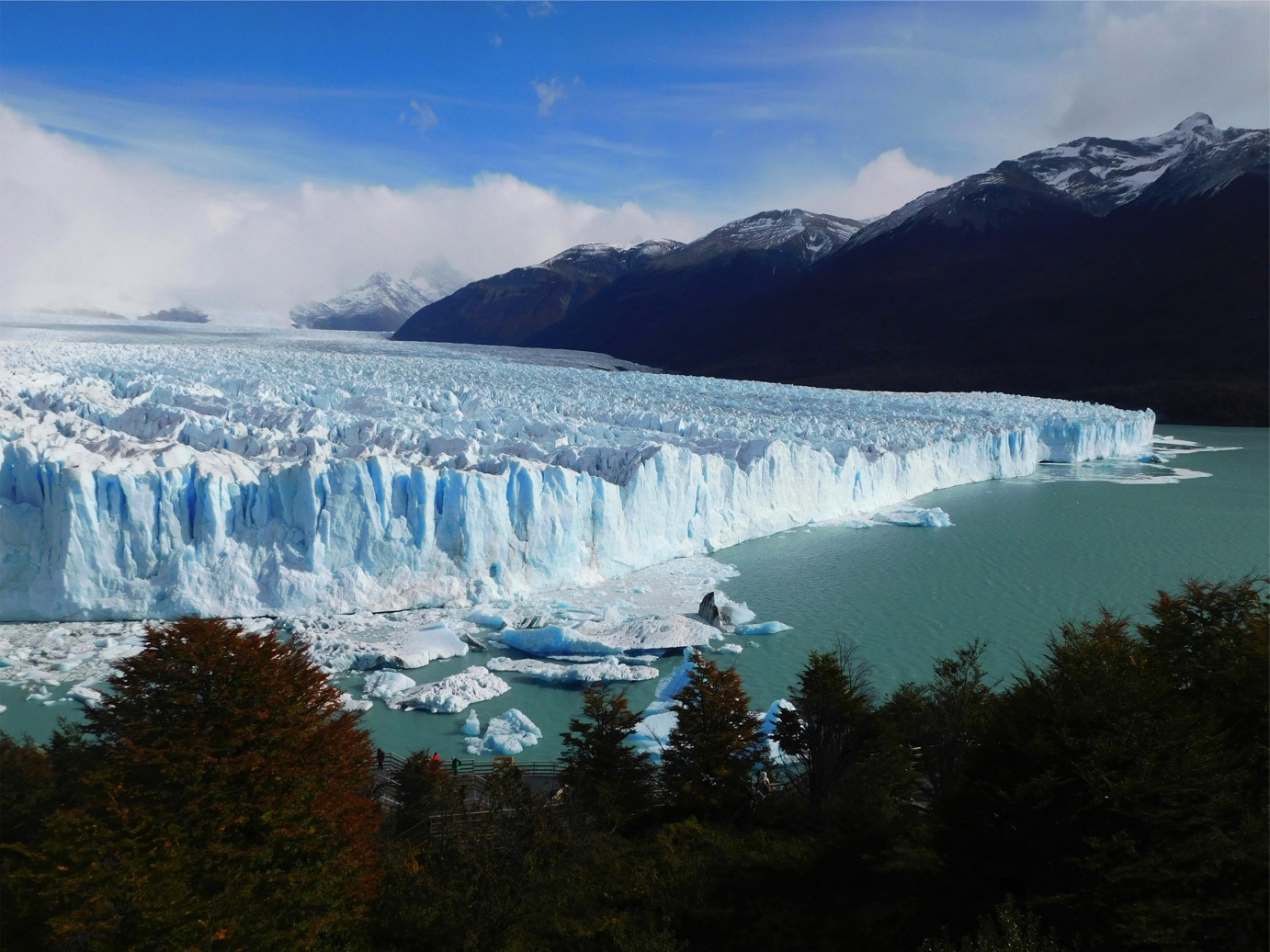
|
|
| |
|
Did you forget about the Climate Emergency?
|
|
Today we are hot to do something, to stand up to the polluters, to demand serious government involvement, to overcome our own excuses and to know in our gut that we can make it right.
We just need to get more people involved, and we just need to energize their participation at every level to really understand what we already know and experience.
Right.. but then comes next week, and we read a good book, watch a movie or take a vacation to somewhere magical... and then we remember that we forgot. And then we experience painful guilt, shame and remorse.
"WHAT is wrong with me??"
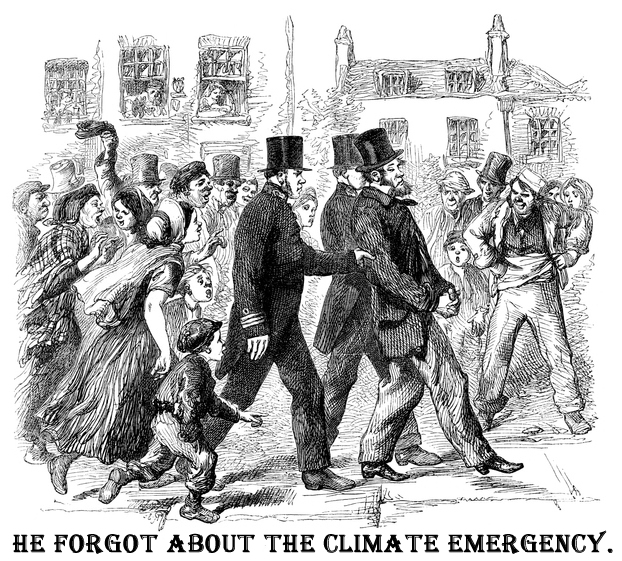
"He forgot about the climate emergency."
In the morning we're in a conversation with someone who tells us to "eat, drink and be merry for tomorrow..." and we do our damnedest to cajole, convince & set those good folks straight.
"If they only knew that it is exactly that sort of thinking that will prevent turning things around." And, well, you know... an hour later we are thinking and speaking the same way as those poor souls. Heck, it really is too big, too awful, and the people in charge seem to have no darned idea, no plan, no courage, other than lip-service and a litany of glittering generalities.
|

I forgot...
Some droll advice for the "guilty that I forgot about the Climate Emergency" syndrome is an affirmation that might sound like this:
"I forgive myself for forgetting, and I know it's OK that I forget. I know that I will do it again.
I know that committed people around me will also forget from time to time, and I will do my best to not judge them for the lapse."
Finally, there is the guilt that we still may be driving a car that pollutes (herendously), or are not careful about our recycling, or that our home or apartment is warmed by fossil fuels.
We will strive to do our best, to do what we can afford, what we can manage, and society and science will have to meet us in the middle with climate awareness and progress. |
|
|
|
Can we make the same commitment to defend
our living planet as we do to guard our freedom?
The Statue of Liberty has always been a symbol to the world to do the right thing.
There is today an amazing disconnect between the lengths we will go to protect our freedom, and the lack of interest, commitment or action to preserve the very world we depend upon.
Liberty is worth championing. That same commitment we make to insure and protect our freedom can also now do the same for our environment, our people and our planet.
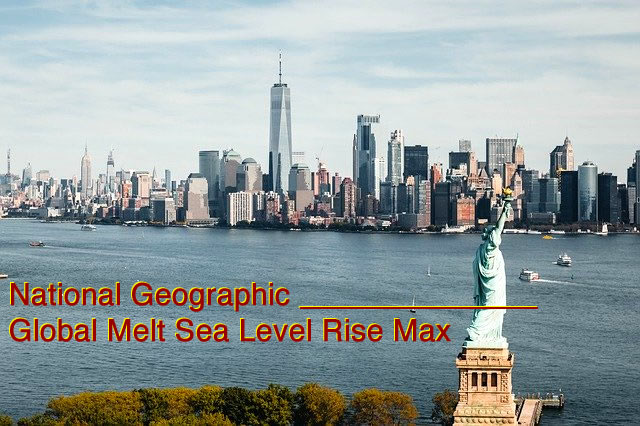
Image by noelsch from Pixabay
NATIONAL GEOGRAPHIC - SEA LEVEL PROJECTIONS
If we continue to burn fossil fuels at the current rate, and ignore calls to remove CO2 from the atmosphere, and if we fail to prevent or choose to ignore the looming massive Methane release in the Northern Tundra, then New York City—and all of Earth's coasts, coastal cities and islands—will succumb to the rising seas within the lifetimes of our children.
And, consider as well that all of that will be accompanied by horrific heat—everywhere on our precious and beautiful planet Earth.
|
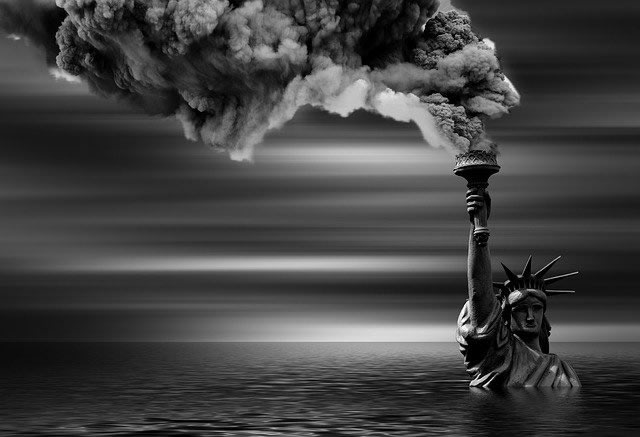
Image by Gerd Altmann from Pixabay
If all of the frozen water in the Arctic...
...Antarctica, Greenland and the glaciers were to melt, the water could rise 216 feet above current sea levels. The awesome image above is intentionally dramatic, and the water level depicted is much higher than predicted.
NATIONAL GEOGRAPHIC • SCIENCE MAGAZINE
But still, look at the picture to the left. Imagine that actual sea level prediction—at Lady Liberty's knees—inundating all the coastlines and coastal cities of your planet.
The good news is that we can reverse all of the negatives... and it will take powerful commitments by a single-minded world community to make this a reality.
It will take an awareness that the last best time to meaningfully act is now.
|
|
|
|
Global Warming sea
level rise
is reversible to a healthy degree...
HALF of all sea-level rise is due to thermal expansion of the seas—the other half is meltwater from glaciers, Greenland and Antarctica. NATIONAL GEOGRAPHIC
With new tech and retrofitting old tech, we can remove massive quantities of Carbon Dioxide from the sky 24/7/365, and we can largely prevent Methane release in the Northern Tundra.
Not only will the melting cease, over time sea levels will begin to fall due to the dual action of thermal contraction and a naturally occurring refreezing.
We must remove CO2 from the atmosphere with every tool we can muster. We should be demanding that -and just as importantly- Methane introduction skyward must be brought under control BEFORE it rachets up its menace.
When someone tells you that massive endeavors such as are posited in this presentation are impractical, or the stuff of fairy tales, have the courage to set them straight:
It's ONLY massive endeavors produced in massive quantities that will supply us with the ability to rise to the occasion, and do what's actually both necessary and prudent.
WW 2 was never about the cost; it was about securing freedom.
Let our goal be about the survival of our children.
Saving our planet will cost many times what was allocated for persuing World War II. Let's be glad for our technologies, regardless of their cost.
The number of trained and dedicated people who will join humanity's most important and must urgent effort ever planned and ever implemented must actually be in the millions of good folks in order to bring us home.
When we stop putting CO2 into our atmosphere—and begin removing it in global-scale quantities with extensive new forests and 1.5 billion CO2 removing cars, trucks, trains, big ships, factories, homes and buildings all over the planet, and when we prevent Methane release in the Northern Tundra, and tasking a good portion of the planet's non-stop never-failing rivers with the 100% CLEAN electrical power to drive tens of millions of CO2 removal devices everywhere—and remove enormous amounts of CO2 in those rivers before they go into the sky, then we will be positioned to secure a future for our world.
It's up to you.......
"Due to the large heat capacity of the ocean and amount of time it takes for water to circulate there is a delay before the full effects of warming can be seen. This also means that there would be a delay between a reduction in atmospheric temperature and the cooling of the oceans." NORTH CAROLINA KING TIDES and NATURE
A realistic projection of allowing all the ice and snow to melt...
|
|
|
 |
You are just the
right person
to save our planet. |

Please consider sharing this website with all those in your circle
whom you feel may be interested or might gain value from.
|
|